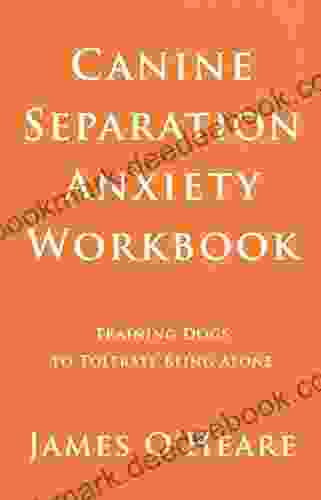Canine Separation Anxiety Workbook: Training Dogs to Tolerate Being Alone

Separation anxiety is a common behavioral problem in dogs, affecting up to 40% of the canine population. It can manifest in a variety of ways, including:
*
4.3 out of 5
| Language | : | English |
| File size | : | 381 KB |
| Text-to-Speech | : | Enabled |
| Screen Reader | : | Supported |
| Enhanced typesetting | : | Enabled |
| Print length | : | 49 pages |
- Barking, howling, or whining when left alone
- Destructive behavior, such as chewing or digging
- Elimination outside of designated areas
- Pacing or restlessness
- Excessive drooling or panting
- Loss of appetite
- Vomiting or diarrhea
Separation anxiety can be a frustrating and challenging problem for dog owners, but it is important to remember that it is a treatable condition. With patience and consistency, it is possible to help your dog overcome their separation anxiety and live a happy and fulfilling life.
What Causes Separation Anxiety?
There are many potential causes of separation anxiety in dogs, including:
*
- A change in routine, such as a new job or school schedule
- A move to a new home
- The loss of a loved one, such as a family member or another pet
- A traumatic experience, such as being abandoned or abused
Some dogs are also more prone to separation anxiety than others. For example, dogs that are highly attached to their owners or that have a history of being left alone for long periods of time are more likely to develop separation anxiety.
How to Treat Separation Anxiety
The treatment for separation anxiety typically involves a combination of behavior modification and medication. Behavior modification techniques can help your dog learn to cope with being left alone, while medication can help to reduce their anxiety levels.
Behavior Modification Techniques
There are a number of different behavior modification techniques that can be used to treat separation anxiety, including:
*
- Desensitization and counterconditioning: This technique involves gradually exposing your dog to being left alone while teaching them to associate being alone with positive things, such as treats or praise.
- Training your dog to stay: This technique involves teaching your dog to stay in one place, even when you are not present.
- Providing your dog with a safe space: This technique involves creating a safe and comfortable space for your dog to retreat to when they are feeling anxious.
- Exercising your dog: Exercise can help to reduce your dog's anxiety levels and make them more relaxed.
Medication
In some cases, medication may be necessary to help reduce your dog's anxiety levels. There are a number of different medications that can be used to treat separation anxiety, including:
*
- Antidepressants: Antidepressants can help to reduce your dog's anxiety levels and improve their mood.
- Anti-anxiety medications: Anti-anxiety medications can help to reduce your dog's anxiety levels and make them more relaxed.
It is important to note that medication should only be used as a last resort, and it should always be used in conjunction with behavior modification techniques.
Canine Separation Anxiety Workbook
This workbook is designed to help you train your dog to tolerate being alone. It includes step-by-step instructions on how to implement a variety of behavior modification techniques, as well as tips on how to manage your dog's anxiety levels.
Step 1: Assess Your Dog's Separation Anxiety
The first step in treating separation anxiety is to assess the severity of your dog's condition. This can be done by observing your dog's behavior when you are away from home.
- Mild separation anxiety: Your dog may bark, whine, or pace when you leave, but they will eventually calm down and settle down.
- Moderate separation anxiety: Your dog may become destructive or eliminate outside of designated areas when you leave.
- Severe separation anxiety: Your dog may vomit, diarrhea, or lose their appetite when you leave.
Once you have assessed the severity of your dog's separation anxiety, you can begin to develop a treatment plan.
Step 2: Develop a Treatment Plan
The treatment plan for your dog's separation anxiety will depend on the severity of their condition. If your dog has mild separation anxiety, you may be able to treat it with behavior modification techniques alone. However, if your dog has moderate or severe separation anxiety, you may need to use medication in addition to behavior modification techniques.
Behavior Modification Techniques
There are a number of different behavior modification techniques that can be used to treat separation anxiety, including:
*
- Desensitization and counterconditioning: This technique involves gradually exposing your dog to being left alone while teaching them to associate being alone with positive things, such as treats or praise.
- Training your dog to stay: This technique involves teaching your dog to stay in one place, even when you are not present.
- Providing your dog with a safe space: This technique involves creating a safe and comfortable space for your dog to retreat to when they are feeling anxious.
- Exercising your dog: Exercise can help to reduce your dog's anxiety levels and make them more relaxed.
Medication
In some cases, medication may be necessary to help reduce your dog's anxiety levels. There are a number of different medications that can be used to treat separation anxiety, including:
*
- Antidepressants: Antidepressants can help to reduce your dog's anxiety levels and improve their mood.
- Anti-anxiety medications: Anti-anxiety medications can help to reduce your dog's anxiety levels and make them more relaxed.
It is important to note that medication should only be used as a last resort, and it should always be used in conjunction with behavior modification techniques.
Step 3: Implement Your Treatment Plan
Once you have developed a treatment plan, it is important to implement it consistently. This means following the steps in the plan every day, even when your dog is not showing signs of separation anxiety.
It is also important to be patient. It may take several weeks or even months for your dog to overcome their separation anxiety. However, with patience and consistency, you can help your dog live a happy and fulfilling life.
Separation anxiety can be a challenging problem, but it is important to remember that it is a treatable condition. With patience and consistency, you can help your dog overcome their separation anxiety and live a happy and fulfilling life.
4.3 out of 5
| Language | : | English |
| File size | : | 381 KB |
| Text-to-Speech | : | Enabled |
| Screen Reader | : | Supported |
| Enhanced typesetting | : | Enabled |
| Print length | : | 49 pages |
Do you want to contribute by writing guest posts on this blog?
Please contact us and send us a resume of previous articles that you have written.
 Book
Book Chapter
Chapter Text
Text Reader
Reader Paperback
Paperback E-book
E-book Newspaper
Newspaper Paragraph
Paragraph Bookmark
Bookmark Shelf
Shelf Glossary
Glossary Bibliography
Bibliography Foreword
Foreword Preface
Preface Footnote
Footnote Manuscript
Manuscript Codex
Codex Tome
Tome Classics
Classics Narrative
Narrative Memoir
Memoir Encyclopedia
Encyclopedia Dictionary
Dictionary Thesaurus
Thesaurus Character
Character Resolution
Resolution Librarian
Librarian Catalog
Catalog Stacks
Stacks Periodicals
Periodicals Study
Study Research
Research Lending
Lending Academic
Academic Journals
Journals Literacy
Literacy Study Group
Study Group Thesis
Thesis Storytelling
Storytelling Awards
Awards Mark Restaino
Mark Restaino Michael Smith
Michael Smith Daniel Wrinn
Daniel Wrinn M Never
M Never Emily Midorikawa
Emily Midorikawa Eric Clark
Eric Clark Giovanni Civardi
Giovanni Civardi Jaime Gasco
Jaime Gasco Gene Kerrigan
Gene Kerrigan Annelise Ryan
Annelise Ryan Jen Green
Jen Green Matt Grossmann
Matt Grossmann Simon Rogers
Simon Rogers Annie Termaat
Annie Termaat Sophie Davidson
Sophie Davidson Anthony Sciarini
Anthony Sciarini Scott Shaw
Scott Shaw T V R Pillay
T V R Pillay Thomas Mann
Thomas Mann Baz Kershaw
Baz Kershaw
Light bulbAdvertise smarter! Our strategic ad space ensures maximum exposure. Reserve your spot today!

 Thomas HardyUnveiling the Secrets of the Roman Triumvirates: A Comprehensive Exploration...
Thomas HardyUnveiling the Secrets of the Roman Triumvirates: A Comprehensive Exploration...
 Howard BlairRun Scout Run: A Journey of Perseverance and Redemption through the Eyes of...
Howard BlairRun Scout Run: A Journey of Perseverance and Redemption through the Eyes of... David MitchellFollow ·13.8k
David MitchellFollow ·13.8k Ben HayesFollow ·4.9k
Ben HayesFollow ·4.9k Emanuel BellFollow ·9.3k
Emanuel BellFollow ·9.3k Jack PowellFollow ·14.7k
Jack PowellFollow ·14.7k Ernest J. GainesFollow ·19.8k
Ernest J. GainesFollow ·19.8k Alex FosterFollow ·6.6k
Alex FosterFollow ·6.6k Patrick RothfussFollow ·15.5k
Patrick RothfussFollow ·15.5k Alexander BlairFollow ·14.2k
Alexander BlairFollow ·14.2k

 Oscar Wilde
Oscar WildeDon't Stop Thinking About the Music: Exploring the Power...
Music is an...

 Floyd Richardson
Floyd RichardsonSnowman Story Problems Math With Santa And Friends
It's a cold winter day, and...

 W. Somerset Maugham
W. Somerset MaughamWhat Every Classroom Teacher Needs To Know: A...
Teaching is a challenging...

 Edgar Cox
Edgar CoxTall Tales But True: A Lifetime of Motorcycling...
I've been riding motorcycles for over 50...

 Chinua Achebe
Chinua AchebeBuni: Happiness Is a State of Mind
Buni is a beautiful...

 Herman Melville
Herman MelvilleThe Arts and Crafts of Older Spain: Embodying the Essence...
In the heart of the Iberian...
4.3 out of 5
| Language | : | English |
| File size | : | 381 KB |
| Text-to-Speech | : | Enabled |
| Screen Reader | : | Supported |
| Enhanced typesetting | : | Enabled |
| Print length | : | 49 pages |








